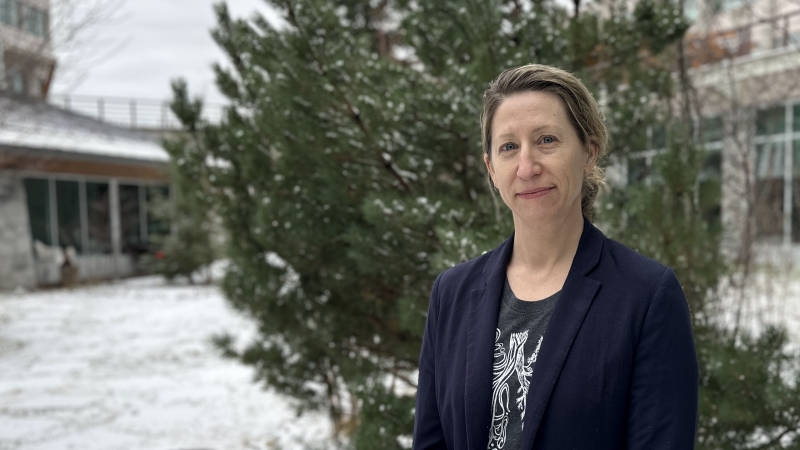Digging deep into herbicide impact on forest ecosystems
In a first for UNBC, Ecosystem Science and Management Associate Professor Dr. Lisa Wood has garnered an Alliance Society grant from the Natural Sciences and Engineering Research Council of Canada to lead a five-year project aimed at better understanding the extent of the impact of glyphosate-based herbicides on forest systems.

After studying the persistence and residues of glyphosate-based herbicides (GBH) in forests for the past 10 years, new research led by UNBC’s Dr. Lisa Wood aims to strengthen this understanding and unearth new insight into the effects of GBH residues on ecosystem health.
“This knowledge is urgently needed, given the large-scale use and persistence of GBH in the natural systems humans and wildlife rely on for high quality ecosystems services, like air and water quality, climate moderation and food sources,” says the Associate Professor in UNBC’s Ecosystem Science and Management program. “We’re focusing on how GBH influences gut bacteria and hormones in organisms in the ‘wild’ forest food web, which is a new direction as previous studies of this type have been conducted in more controlled settings.”
Wood and her team have been awarded a Natural Sciences and Engineering Research Council of Canada (NSERC) Alliance grant worth more than $1.5 million with partner in-kind contributions for the five-year project.
The grant is a first for UNBC. With rigorous criteria, the Alliance cost-sharing option 2, recently re-named the Alliance Society grant, is only awarded to projects addressing significant societal challenges.
While consistently finding glyphosate residues in forest plants in past studies, Wood and her collaborators have also documented a reduction in forest foods for wildlife, changes in the chemistry of residual foods present after treatment and they’ve noted how environmental conditions such as temperature and photoperiod impact residue breakdown. Building on that body of work, this new project will delve into if, and how, changes to forest vegetation influence the health of wildlife at different levels in the food chain.
Composed of seven researchers, the team also includes Dr. Heather Bryan and Dr. Dezene Huber from UNBC; UBC-Okanagan researchers Drs. Deanna Gibson, Miranda Hart and Susan Murch; and Dr. Jeff Werner from the B.C. Ministry of Water, Land and Resource Stewardship.
“It was vital to have each member on this team as each brings their own expertise of specific taxa and/or analytical techniques,” Wood explains. “We wanted to be able to draw conclusions that apply over an ecological forest system, rather than just at the organismal level, requiring experts from multiple backgrounds of biology and chemistry.”
The researchers have partnered with the Swan River First Nation (a member of the Treaty 8 First Nations), the Alberta Trappers Association, the British Columbia Trappers Association and the British Columbia Wildlife Federation. As a result of many meetings over the past two years, Wood says each partner contributed to formulating the important questions to ask in the research project and determining which species would be important, relevant and rigorous to study.
“It was crucial to meaningfully incorporate each perspective,” says the lead researcher. “As we will generate and transfer knowledge to our partners and to the public, who use the land to obtain food and medicines and to recreate.”
The NSERC Alliance grant will help to support at least nine graduate students, five undergraduate research students and three research technicians over the next five years, with studies ranging from examining soil microbes to investigating large vertebrates.
“The NSERC Alliance grant is a huge win for Lisa and her research team, and a reflection of the significant and impactful research being led by UNBC in strong collaboration with its partners,” says Vice President Research and Innovation, Dr. Paula Wood-Adams. “This team will generate new knowledge, while training young researchers in areas that are important to Canada and will help inform and guide partner organizations in their future policy and land use plans.”
The project aligns with the federal government’s priority to conduct research of importance to Indigenous Peoples and to reconcile with First Nations.
“Healthy lands for First Nation communities equate to areas where food can be harvested without the risk of contamination from chemicals like glyphosate. These food harvesting practices lead to good health, cultural wellness and food sovereignty,” she says. “Providing research to amplify Indigenous voices on issues of concerns supports reconciliation efforts.”
Results from the project could act as a model for similar work in other ecosystems across the country and beyond.
“Canadians will benefit from the research conducted by better understanding the extent of the impact of GBH on forest systems,” says Wood. “Our partner organizations will use this information to support their mandates and advocate for updates to policy, where warranted.”
